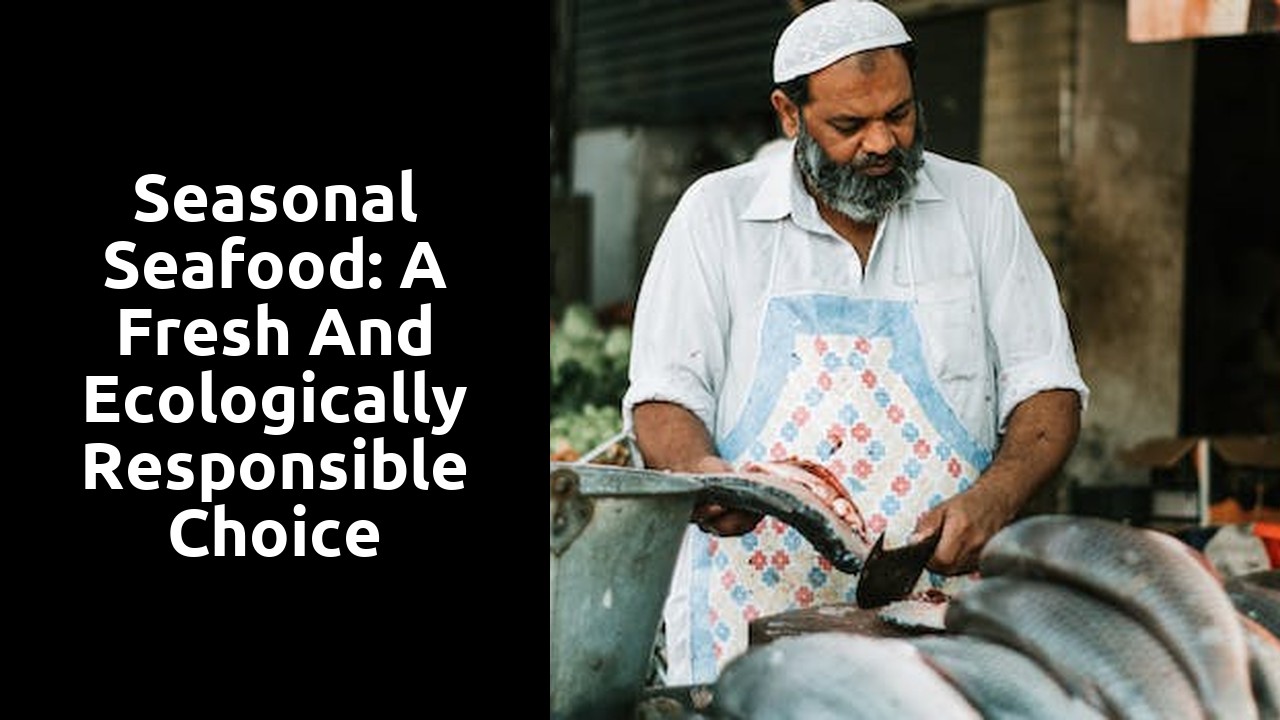
Seasonal Seafood: A Fresh and Ecologically Responsible Choice
The Environmental Impact of Your Seafood Choices
When it comes to seafood, the choices you make can have a significant impact on the environment. Overfishing, pollution, and habitat destruction are just some of the consequences of unsustainable fishing practices. By understanding the environmental impact of your seafood choices, you can make informed decisions that contribute to the long-term health and sustainability of our oceans.
One of the main factors to consider is overfishing. Many fish stocks around the world are being depleted faster than they can reproduce, leading to population declines and even the collapse of certain species. This not only disrupts the delicate balance of marine ecosystems but also affects the livelihoods of fishermen who depend on these resources. Sustainable fishing practices, such as setting catch limits and implementing fishing gear that minimizes bycatch, are crucial for ensuring the future availability of seafood and preserving biodiversity in our oceans.
Locally Sourced Delicacies: Making a Difference with Your Palate
Locally sourced delicacies are not only a treat for your taste buds but also a way to make a positive impact on the environment. By choosing seafood that is caught or harvested in your local area, you are supporting local fishermen and reducing the carbon footprint associated with long-distance transportation. Not to mention, by opting for local delicacies, you are also getting the freshest and most flavorful seafood available.
When you choose locally sourced seafood, you are not only supporting the local economy but also helping to preserve marine ecosystems. Local fishermen often employ sustainable fishing practices, such as using selective fishing techniques and avoiding overfished species. By supporting these fishermen, you are encouraging the continuation of these sustainable practices and helping to maintain the delicate balance of marine ecosystems. Plus, knowing where your seafood comes from and how it was harvested can give you peace of mind that you are making a responsible and ethical choice for your plate.
Exploring the Bounty of the Ocean: A Sustainable Approach
Exploring the vast bounty of the ocean is an adventure that never fails to captivate our senses. With every bite of seafood, we can taste the richness of flavors that come from the depths of its waters. But as our appetites for seafood grow, so does the need for a sustainable approach to the harvesting and consumption of these ocean delicacies.
A sustainable approach to exploring the ocean means striking a delicate balance between satisfying our gastronomic desires and preserving the delicate ecosystem that supports this abundance of marine life. It means choosing seafood that has been responsibly harvested, ensuring that we are not depleting fish populations or harming their habitats. By taking the time to understand where our seafood comes from, we can make informed choices that support local fishermen who are committed to sustainable practices and contribute to the preservation of our oceans for generations to come.
Supporting Local Fishermen: The Key to Preserving Marine Ecosystems
Supporting local fishermen is not just about ensuring a constant supply of fresh seafood; it is also a crucial step towards preserving marine ecosystems. The livelihoods of these fishermen depend on the health and sustainability of the oceans. By supporting local fishing communities, we are directly contributing to the conservation of marine life and the overall well-being of the ocean.
Local fishermen are intimately connected to their surrounding marine ecosystems. They possess knowledge and experience that has been passed down through generations, enabling them to fish in a sustainable manner. Unlike large-scale commercial fishing operations, local fishermen have a vested interest in responsibly harvesting seafood, as they rely on these resources for their income and survival. By choosing to buy from local fishermen, we are supporting their efforts to preserve the delicate balance of marine ecosystems for future generations.
From Ocean to Plate: The Journey of Responsibly Harvested Seafood
When it comes to enjoying seafood, understanding the journey from ocean to plate is crucial for making responsible choices. The process begins with the harvesting of the seafood, which can be done through a variety of methods such as fishing or aquaculture. In the case of wild-caught seafood, fishermen venture out into the vast oceans to catch fish using nets, lines, or traps. This traditional method captures fish in their natural habitats, ensuring minimal disruption to the marine ecosystem. On the other hand, aquaculture involves the cultivation of seafood in controlled environments such as fish farms or ponds. This method allows for the sustainable production of seafood and reduces the pressure on wild fish populations.
The Health Benefits of Fresh and Sustainable Seafood Options
Fresh and sustainable seafood options not only provide a delectable dining experience, but also offer numerous health benefits. Consuming seafood as part of a well-balanced diet has been linked to a lower risk of heart disease. Rich in omega-3 fatty acids, fish such as salmon, mackerel, and sardines can help reduce blood clotting, decrease triglyceride levels, and lower blood pressure. Additionally, these fatty acids have been shown to improve brain function and help combat depression and anxiety. Incorporating fresh and sustainable seafood into your meals can contribute to a healthier heart and a sharper mind.
Furthermore, seafood is an excellent source of high-quality proteins. These proteins are essential for growth, repair, and maintenance of body tissues. They contain all the essential amino acids that our bodies need but can't produce on their own. Eating seafood can also promote the development and maintenance of strong bones. Fish like tuna and salmon are rich in vitamin D, which aids in the absorption of calcium and plays a crucial role in bone health. By choosing fresh and sustainable seafood options, you are not only nourishing your body but also enjoying the benefits of a protein-rich and bone-strengthening diet.
Related Links
Connection to Nature and Seasonal Seafood ConsumptionSeasonal Seafood and Cultural Traditions
Sustainable Fishing Practices and Seasonal Seafood
Supporting Local Fisheries through Seasonal Seafood
Quality and Flavor Advantages of Seasonal Seafood